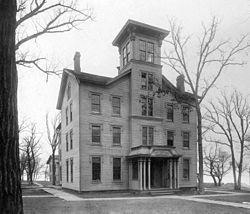
Elmira College is a private college in Elmira, New York. Founded as a college for women in 1855, it is the oldest existing college granting degrees to women that were the equivalent of those given to men. Elmira College became coeducational in all of its programs in 1969. As of 2023, the college has an enrollment of approximately 657 students.

Marycrest College Historic District is located on a bluff overlooking the West End of Davenport, Iowa, United States. The district encompasses the campus of Marycrest College, which was a small, private collegiate institution. The school became Teikyo Marycrest University and finally Marycrest International University after affiliating with a Japanese educational consortium during the 1990s. The school closed in 2002 because of financial shortcomings. The campus has been listed on the Davenport Register of Historic Properties and on the National Register of Historic Places since 2004. At the time of its nomination, the historic district consisted of 13 resources, including six contributing buildings and five non-contributing buildings. Two of the buildings were already individually listed on the National Register.

Dwinelle Hall is the second largest building on the campus of the University of California, Berkeley. It was completed in 1952. It is named after John W. Dwinelle, the state assemblyman responsible for the Organic Act that established the University of California in 1868, and who went on to serve as one of the first Regents of the University of California. Dwinelle is home to many of the humanities and social sciences departments of the College of Letters and Science: namely, the departments of classics, rhetoric, linguistics, history, comparative literature, South and Southeast Asian studies, film studies, French, German, Italian studies, Scandinavian, Slavic languages, Spanish and Portuguese, and gender and women's studies.

Buena Vista University is a private university in Storm Lake, Iowa. Founded in 1891 as Buena Vista College, it is affiliated with the Presbyterian Church. The university's 60-acre (240,000 m2) campus is situated on the shores of Storm Lake, a 3,200-acre (13 km2) natural lake.
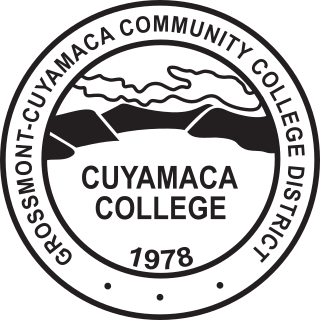
Cuyamaca College is a public community college in Rancho San Diego, California. It is part of the Grossmont-Cuyamaca Community College District and the California Community Colleges System. Along with Grossmont College, it serves the eastern suburbs in the San Diego area. Cuyamaca College opened in 1978 and now offers 81 associate's degree programs and 66 training certification programs to approximately 8,500 students. Many of the college's students transfer to the University of California, San Diego or San Diego State University to complete their bachelor's degrees. Cuyamaca's mascot is the coyote.

Culver–Stockton College is a private Christian liberal arts college in Canton, Missouri. It was founded as Christian University in 1853 as the first institution west of the Mississippi River chartered specifically for men and women. As of fall 2022, the college enrolled 999 students.

The Main Campus is the primary campus of North Carolina State University, located in Raleigh, North Carolina, US, inside the Beltline. Notable features of Main Campus include the Bell Tower and D. H. Hill Library. The campus is known for its distinctive red brick buildings, sidewalks, plazas, and sculptures; some are dotted with decorative brick mosaics. University Plaza is nicknamed "The Brickyard" because it is mostly a flat, open, bricked area.
The history of Northwestern University can be traced back to a May 31, 1850, meeting of nine prominent Chicago businessmen who shared a desire to establish a university to serve the former Northwest Territory. On January 28, 1851, the Illinois General Assembly granted a charter to the Trustees of the North-Western University making it the first recognized university in Illinois.[a] While the original founders were devout Methodists and affiliated the university with Methodist Episcopal Church, they were committed to non-sectarian admissions.

Charles Deering Library is an academic library of Northwestern University, a private research university in Evanston, Illinois. Deering served as the university's main library on the Evanston campus from 1933, when it was established, until the construction of the Northwestern University Main Library in 1970.

University Hall is the oldest original building on the Northwestern University campus in Evanston, Illinois, and the second building to have been constructed after Old College, which stood on campus until the 1970s. The building has served a wide range of different roles since its construction, and currently houses the university's English department.
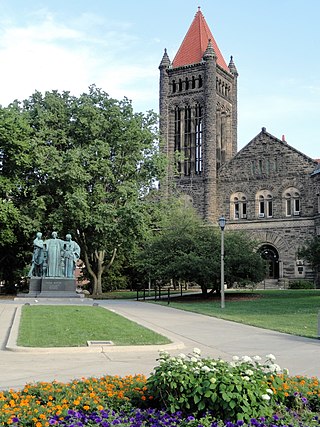
"Altgeld's castles" are buildings in the Gothic Revival style at five Illinois public universities, all built at the initiative or inspiration of Illinois Governor John Peter Altgeld During his term as governor (1893-1897), Altgeld expressed certain opinions on how buildings should be erected in the state of Illinois. In his second biennial message to the state legislature, he discussed how buildings were being constructed without consideration for their outward appearance. He stated that it was time for buildings to become more aesthetically pleasing in addition to being functional, and he suggested the "Tudor-Gothic style" as the most inexpensive way to do this. Consequently, several of the state universities in Illinois erected buildings which resembled castles in his honor. College folklore states that these buildings have aligned corridors and rooms so that they could all be "put together" to create one large building, but there is no evidence to support this rumor.
The campus of Northwestern University encompasses two campuses in Evanston, Illinois and Chicago, Illinois, United States. There is an additional campus located in Doha, Qatar which offers bachelor's and master's degrees. The original Evanston campus has witnessed approximately 150 buildings rise on its 240 acres (0.97 km2) since the first building opened in 1855. The downtown Chicago campus of approximately 25 acres (100,000 m2) is home to the schools of medicine and law was purchased and constructed in the 1920s and 1930s.
The University of Arkansas Campus Historic District is a historic district that was listed on the National Register of Historic Places on September 23, 2009. The district covers the historic core of the University of Arkansas campus, including 25 buildings.

Peabody Hall is a mixed-use academic and residential building located on the campus of Miami University in Oxford, Ohio. The original building, known as Seminary Hall, was built in 1855, and was the central building of Western College for Women. That building burned down in 1860 and was rebuilt the following year, only to become damaged by an 1871 fire. The building was rebuilt again that same year, and was renamed Peabody Hall in 1905. Peabody Hall is one of two residential buildings on Miami's Western Campus still used for their original purposes. It is one of 15 contributing buildings to the Western Female Seminary National Historic District.
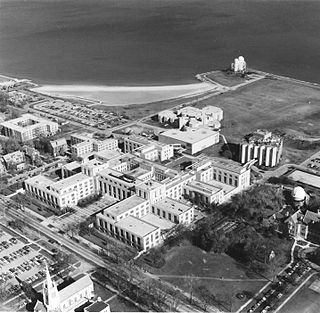
The Northwestern University Lakefill is a large area of Northwestern University land that was reclaimed from Lake Michigan in 1962–1964 by creating a seawall of limestone blocks quarried in Illinois and Indiana and using landfill materials from the construction of the Port of Indiana. The lakefill resulted from the university's need to expand the campus's physical footprint; Northwestern President J. Roscoe Miller received permission from the town of Evanston and the Illinois legislature to reclaim 74 acres of underwater land. This almost doubled the size of the previously 85 acres campus. In 1968, the lakefill was expanded by an additional 10 acres on the southern end of the campus.

The University of Scranton, built on a 58-acre campus, is located in the city of Scranton, Pennsylvania. The campus serves a community of 75,000 people within the greater metropolitan area Since gaining university status in 1938, the institution has undertaken over 50 renovation projects. More than $240 million has been spent on new construction, including the Loyola Science Center, DeNaples Center, Pilarz and Montrone Halls, Condron Hall, Edward R. Leahy, Jr. Hall, and the Dionne Green locations.

Irvin Hall was the first permanent building at Highland University in Highland, Kansas. It is the oldest building in Kansas still used for higher education.
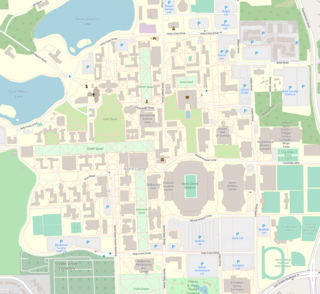
The campus of the University of Notre Dame is located in Notre Dame, Indiana, and spans 1,250 acres comprising around 170 buildings. The campus is consistently ranked and admired as one of the most beautiful university campuses in the United States and around the world, particularly noted for the Golden Dome, the Basilica and its stained glass windows, the quads and the greenery, the Grotto, Touchdown Jesus, its collegiate gothic architecture, and its statues and museums. Notre Dame is a major tourist attraction in northern Indiana; in the 2015–2016 academic year, more than 1.8 million visitors, almost half of whom were from outside of St. Joseph County, visited the campus.

University Hall is the main academic building at the Ohio State University in Columbus, Ohio. The building houses classrooms for several of the university's colleges and includes a museum on the ground floor.
